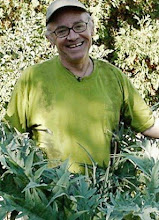 Tomato planting
Tomato planting Developing potato tower
Developing potato tower Garlic flower bud harvest
Garlic flower bud harvest Sesame seed flowers from last season
Sesame seed flowers from last season lettuce in the onions needs to be thinned
lettuce in the onions needs to be thinned Gas Plant blisters and injury - the seed pods cause the photo dermatitis
Gas Plant blisters and injury - the seed pods cause the photo dermatitis

Early this week my thermometer on the garden shed ( facing North) hit 100 degrees! No wonder I had apples scald in the plastic bags for the FIRST TIME EVER! In past years later in the season we have had extremely hot weather and the apples did not scald. But, with the small young apples in the bags only a little more than a week, they seem to have taken it on the chin. Most of the scald was on the small tree in the garden that is in a dead air spot so the hot noon sun can really focus on those apples. Luckily I found some missed fruit inside the tree that was still not bagged so I bagged those apples and pruned out the sun scalded fruit.
The tomatoes have really jumped with this hot weather. They are all strung up and mulched with straw. I do not have enough watering jugs to do the whole planting of 60 tomato plants, so I have asked a friend to save me some from the place that she works ( THANKS KATHY). I create one small hole in the bottom of each jug have opposite the handle. When I fill the jugs, I tighten the lid full and then open it a quarter turn for a slow drip of the water to the tomato roots. Usually I have enough rain water from the five rain barrels to do the tomatoes for several waterings but that is not possible this season for construction reasons so I will have to use tap water. I will give each plant 2 gal of water per week if we do not get an inch of rain. The straw mulch is vital to a good crop. Mulching tomatoes is the best way to avoid blossom end rot - the ever present scourge of tomato growers - which is the result of inconsistent water supply to the developing fruits. Keep the plants mulched and watered and that problem goes away. The same is true for tomatoes grown in pots. The roots must be kept cool and evenly moist to produce a crop so "TopseTurvie" tomatoes are a real good idea.
The potato towers are fully planted and seem to be growing. Flowers on some of the potatoes would mean that one could steal some developing spuds but the towers do not lend themselves to this early potato luxury so we will have wait until harvest time. Lettuce suffers from the heat so I make sure that the lettuce gets some moisture every few days to keep it fresh. I did plant another flat of lettuce so I will also start another seedling flat this next week. Bean seeds need to be planted in peat pots this week to start the process for our favorite pole bean crop. Cucumbers were transplanted onto one trellis and I will start a second planting this week too. Some of the lettuce in the onions is past prime and needs to be removed and some has grown so well that it has shaded the developing onions and beets so it will have to be removed for their sake. Besides, it makes good compost and will help remove some of the developing slugs. I cut the developing garlic flowers off the second garlic planting. The are edible and we had some in soup tonight. I also transplanted both white and black sesame seedlings this week. Susan's home made bread is great with the addition of these seeds so I have planted them again this year to see if we can have a larger harvest than last season. Once we have the seed we will share the bread recipe - a no kneed French bread that is excellent.
Now a word to the wise. I was working with Gas Plant (Dictamnus albus) on Monday and did not know that the developing seed pods that are on the plant at this time of the year are very TOXIC. The hairs of the seed pods produce a photo toxic substance that will severely burn some people when they touch the pods and then expose that skin to sunlight. Photo dermatitis from this plant is bad and I got a bad case on my left hand. The pictures show the results. Avoid touching this plant at seed stage. A neighbor had the same experience and she still has the spots a year after the exposure. Check out "Gas Plant" toxicity on the web for future information.
Happy Gardening






















